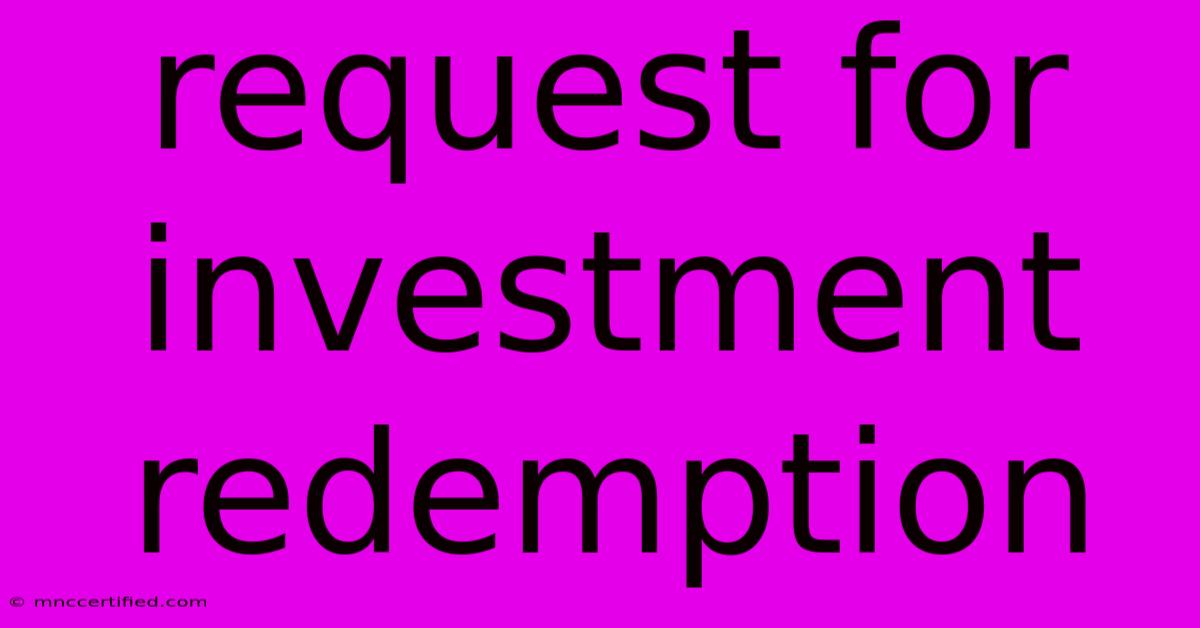Request For Investment Redemption

Table of Contents
Request for Investment Redemption: A Comprehensive Guide
Requesting a redemption of your investment can feel daunting, but understanding the process and your rights is crucial. This guide provides a comprehensive overview of how to initiate a redemption request, what to expect, and how to navigate potential challenges. We'll cover everything from understanding your investment agreement to dealing with delays or denials.
Understanding Your Investment Agreement
Before initiating a redemption request, carefully review your investment agreement. This document outlines the terms and conditions of your investment, including:
- Redemption Procedures: This section details the exact steps you need to take to request a redemption. It often includes forms to complete, deadlines to meet, and required documentation. Pay close attention to any specific requirements or restrictions.
- Redemption Fees: Many investments charge fees for early redemption. Understand these fees upfront to avoid unexpected costs. Your agreement should clearly specify the amount and calculation method.
- Redemption Timeline: The agreement should state how long the process is expected to take. Knowing this timeframe allows for realistic expectations.
- Minimum Redemption Amounts: Some investments might have minimum redemption amounts. Check your agreement to ensure your request meets these criteria.
- Redemption Restrictions: Certain investments might have restrictions on when redemptions are allowed, such as lock-up periods or limitations during specific market conditions.
Failure to adhere to the terms outlined in your investment agreement could delay or even prevent your redemption.
Step-by-Step Guide to Requesting Redemption
The exact steps involved in requesting a redemption vary depending on the investment type and the issuing entity. However, a general process usually follows these steps:
- Review Your Investment Agreement: Thoroughly review your agreement to understand the process, fees, and any restrictions.
- Complete the Redemption Request Form: Download and carefully complete the official redemption request form provided by your investment provider. Ensure all information is accurate and complete.
- Gather Required Documentation: This might include identification documents, proof of ownership, and any other documents specified in the agreement.
- Submit Your Request: Submit your completed form and supporting documentation according to the instructions provided. This might involve mailing it, submitting it online, or delivering it in person.
- Confirmation of Receipt: After submission, request confirmation of receipt from your investment provider. This creates a record of your request and establishes a timeline for processing.
- Monitor the Process: Track the progress of your redemption request. Regularly contact your provider if you haven't received updates within the expected timeframe.
- Receive Your Funds: Once the redemption is processed, you'll receive your funds according to the payment method specified in your agreement.
Dealing with Delays or Denials
Delays in processing redemption requests are sometimes unavoidable, but persistent delays or outright denials require immediate attention.
- Understand the Reasons for Delays: Contact your investment provider to inquire about the cause of any delay. They may need additional information or be facing internal processing issues.
- Document All Communication: Maintain records of all communication with your provider, including emails, letters, and phone calls.
- Escalate the Issue: If the delay is unreasonable or you suspect misconduct, escalate the issue to a higher authority within the organization. Consider consulting a financial advisor or lawyer if necessary.
- Consider Legal Action: In cases of unjustified denial or significant delays, you might need to consult a legal professional to explore legal options.
Choosing the Right Investment Strategy
Understanding the redemption process is a vital part of responsible investing. Before committing to any investment, consider:
- Liquidity Needs: Assess your short-term and long-term liquidity needs. Investments with restrictive redemption policies might not be suitable if you anticipate needing access to your funds quickly.
- Risk Tolerance: Understand the associated risks and potential for loss. High-growth investments often have stricter redemption terms.
- Diversification: Diversify your investment portfolio to reduce risk. Don't put all your eggs in one basket.
By carefully reviewing your investment agreement, following the redemption procedures diligently, and understanding your rights, you can navigate the investment redemption process successfully. Remember, proactive communication and documentation are key to a smooth and timely redemption.

Thank you for visiting our website wich cover about Request For Investment Redemption. We hope the information provided has been useful to you. Feel free to contact us if you have any questions or need further assistance. See you next time and dont miss to bookmark.
Featured Posts
-
What Is A Maximum Investment Plan
Nov 20, 2024
-
Argentina Residency By Investment
Nov 20, 2024
-
Drue Cicchetto Fisher Investments
Nov 20, 2024
-
United Methodist Church Insurance
Nov 20, 2024
-
Investment Banking Learning Curve
Nov 20, 2024